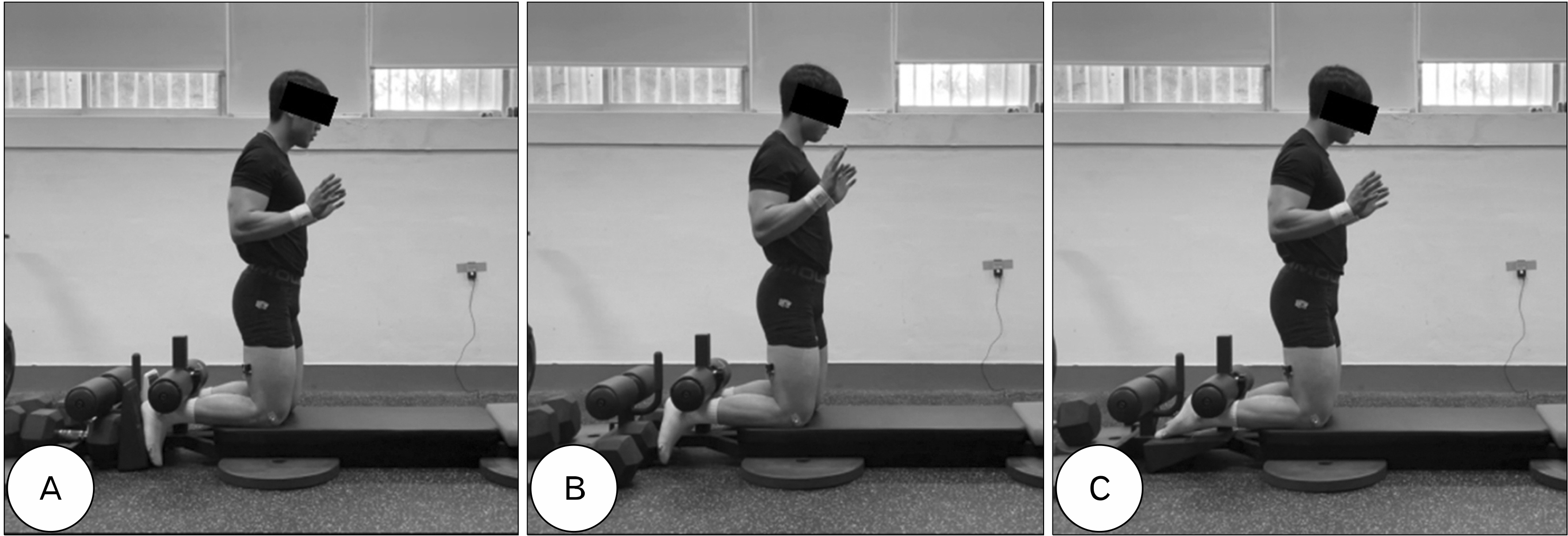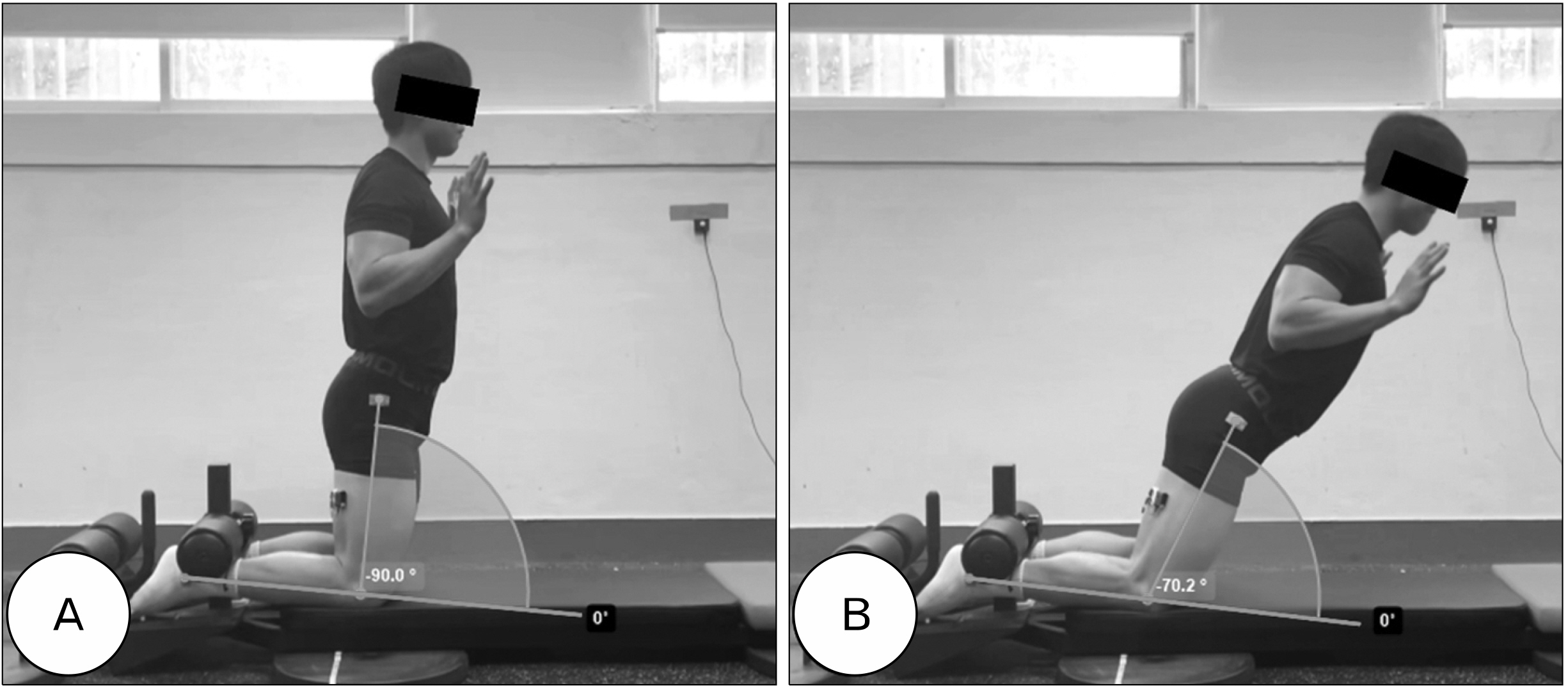Korean J Sports Med.
2024 Dec;42(4):254-261. 10.5763/kjsm.2024.42.4.254.
Effect of Ankle Joint Flexion Angle on Lower Extremity Muscle Activity and Break Point Angle during Nordic Hamstring Exercises in Amateur Soccer Players
- Affiliations
-
- 1Marine Sports Major, Department of Smart Healthcare, Pukyong National University, Busan, Korea
- 2Department of Physical Therapy, Pusan National University Yangsan Hospital, Yangsan, Korea
- KMID: 2561753
- DOI: http://doi.org/10.5763/kjsm.2024.42.4.254
Abstract
- Purpose
The purpose of this study was to determine the effects of ankle dorsiflexion, neutral, and plantarflexion on lower extremity muscle activity and break point angle (BPA) during Nordic hamstring exercises.
Methods
Twenty-four members of a college soccer club (age, 21.68±2.39 years; height, 175.63±4.76 cm; weight, 71.88±6.29 kg) were recruited to participate in the experiment, and all subjects were measured three times in triplicate for Nordic hamstrings at three different ankle angles with all subjects in one group. Surface electromyography equipment (miniDTS, Noraxon Inc.) was used to acquire 3 seconds of muscle activity data at the starting point (90°) during exercise, and motion analysis software (Kinovea version 0.9.5, Kinovea) was used to collect kinematic data at the point where knee strike angular velocity exceeded 30°/sec for BPA data acquisition.
Results
The results of this study, lower extremity muscle activity was not significantly different in the three variants of Nordic hamstring exercises, but BPA was significantly lower in the dorsiflexion position (60.28°±6.35°) compared to the neutral position (65.32°±6.35°) and plantarflexion position (63.82°±7.01°) (p< 0.001).
Conclusion
These results suggest that the dorsi flexion position of the ankle during Nordic hamstring exercises allows the body to maintain the position for a longer period of time against eccentric forces in situations where the body is moving forward. This suggests that the ankle dorsi flexion position can be used as a position for effective Nordic hamstring exercises in amateur soccer players.
Figure
Reference
-
1. van der Horst N, Smits DW, Petersen J, Goedhart EA, Backx FJ. 2015; The preventive effect of the nordic hamstring exercise on hamstring injuries in amateur soccer players: a randomized controlled trial. Am J Sports Med. 43:1316–23. DOI: 10.1177/0363546515574057. PMID: 25794868.2. Kerkhoffs GM, van Es N, Wieldraaijer T, Sierevelt IN, Ekstrand J, van Dijk CN. 2013; Diagnosis and prognosis of acute hamstring injuries in athletes. Knee Surg Sports Traumatol Arthrosc. 21:500–9. DOI: 10.1007/s00167-012-2055-x. PMID: 22622781. PMCID: PMC3549245.3. Bisciotti GN, Chamari K, Cena E, et al. 2019; Hamstring injuries prevention in soccer: a narrative review of current literature. Joints. 7:115–26. DOI: 10.1055/s-0040-1712113. PMID: 34195539. PMCID: PMC8236328.4. Yagiz G, Akaras E, Kubis HP, Owen JA. 2021; Heterogeneous effects of eccentric training and Nordic hamstring exercise on the biceps femoris fascicle length based on ultrasound assessment and extrapolation methods: a systematic review of randomised controlled trials with meta-analyses. PLoS One. 16:e0259821. DOI: 10.1371/journal.pone.0259821. PMID: 34752499. PMCID: PMC8577763.5. Seagrave RA, Perez L, McQueeney S, Toby EB, Key V, Nelson JD. 2014; Preventive effects of eccentric training on acute hamstring muscle injury in professional baseball. Orthop J Sports Med. 2:2325967114535351. DOI: 10.1177/2325967114535351. PMID: 26535336. PMCID: PMC4555601.6. Mjølsnes R, Arnason A, Østhagen T, Raastad T, Bahr R. 2004; A 10-week randomized trial comparing eccentric vs. concentric hamstring strength training in well-trained soccer players. Scand J Med Sci Sports. 14:311–7. DOI: 10.1046/j.1600-0838.2003.367.x. PMID: 15387805.7. Thorborg K. 2012; Why hamstring eccentrics are hamstring essentials. Br J Sports Med. 46:463–5. DOI: 10.1136/bjsports-2011-090962. PMID: 22661695.8. Brockett CL, Morgan DL, Proske U. 2001; Human hamstring muscles adapt to eccentric exercise by changing optimum length. Med Sci Sports Exerc. 33:783–90. DOI: 10.1097/00005768-200105000-00017. PMID: 11323549.9. Hu C, Du Z, Tao M, Song Y. 2023; Effects of different hamstring eccentric exercise programs on preventing lower extremity injuries: a systematic review and meta-analysis. Int J Environ Res Public Health. 20:2057. DOI: 10.3390/ijerph20032057. PMID: 36767424. PMCID: PMC9916392.10. Sayers A, Sayers BE. 2008; The Nordic eccentric hamstring exercise for injury prevention in soccer players. Strength Cond J. 30:56–8. DOI: 10.1519/SSC.0b013e31817f985d.11. Iga J, Fruer CS, Deighan M, Croix MD, James DV. 2012; 'Nordic' hamstrings exercise: engagement characteristics and training responses. Int J Sports Med. 33:1000–4. DOI: 10.1055/s-0032-1304591. PMID: 22895870.12. Petersen J, Thorborg K, Nielsen MB, Budtz-Jørgensen E, Hölmich P. 2011; Preventive effect of eccentric training on acute hamstring injuries in men's soccer: a cluster-randomized controlled trial. Am J Sports Med. 39:2296–303. DOI: 10.1177/0363546511419277. PMID: 21825112.13. Vicente-Mampel J, Bautista IJ, Martín F, Maroto-Izquierdo S, Van Hooren B, Baraja-Vegas L. Effects of ankle position during the Nordic Hamstring exercise on range of motion, heel contact force and hamstring muscle activation. Sports Biomech. 2022; Jan. 20. [Epub]. https://doi.org/10.1080/14763141.2021.2025416. DOI: 10.1080/14763141.2021.2025416. PMID: 35045792.14. Sconce E, Heller B, Maden-Wilkinson T, Hamilton N. 2021; Agreement between methods and terminology used to assess the kinematics of the Nordic hamstring exercise. J Sports Sci. 39:2859–68. DOI: 10.1080/02640414.2021.1968127. PMID: 34459716.15. Soga T, Yamaguchi S, Inami T, et al. 2023; Hamstring activity before and after break-point angle calculated by smartphone application during the Nordic hamstring exercise. Int J Sports Phys Ther. 18:1290–8. DOI: 10.26603/001c.89271. PMID: 39282209. PMCID: PMC11401651.16. Soga T, Nishiumi D, Furusho A, Akiyama K, Hirose N. 2021; Effect of different slopes of the lower leg during the Nordic hamstring exercise on hamstring electromyography activity. J Sports Sci Med. 20:216–21. DOI: 10.52082/jssm.2021.216. PMID: 33948099. PMCID: PMC8057708.17. Šarabon N, Marušič J, Marković G, Kozinc Ž. 2019; Kinematic and electromyographic analysis of variations in Nordic hamstring exercise. PLoS One. 14:e0223437. DOI: 10.1371/journal.pone.0223437. PMID: 31644582. PMCID: PMC6808554.18. Comfort P, Regan A, Herrington L, Thomas C, McMahon J, Jones P. 2017; Lack of effect of ankle position during the Nordic curl on muscle activity of the biceps femoris and medial gastrocnemius. J Sport Rehabil. 26:202–7. DOI: 10.1123/jsr.2015-0130. PMID: 27632836.19. Li L, Landin D, Grodesky J, Myers J. 2002; The function of gastrocnemius as a knee flexor at selected knee and ankle angles. J Electromyogr Kinesiol. 12:385–90. DOI: 10.1016/S1050-6411(02)00049-4. PMID: 12223171.20. Zeller BL, McCrory JL, Kibler WB, Uhl TL. 2003; Differences in kinematics and electromyographic activity between men and women during the single-legged squat. Am J Sports Med. 31:449–56. DOI: 10.1177/03635465030310032101. PMID: 12750142.21. Ditroilo M, De Vito G, Delahunt E. 2013; Kinematic and electromyographic analysis of the Nordic Hamstring Exercise. J Electromyogr Kinesiol. 23:1111–8. DOI: 10.1016/j.jelekin.2013.05.008. PMID: 23809430.22. Fruer SA. Electromyographic analysis of the hamstrings during the 'Nordic' hamstring exercise [dissertation]. University of Gloucestershire;2008.23. Schoenfeld BJ, Contreras B, Tiryaki-Sonmez G, Wilson JM, Kolber MJ, Peterson MD. 2015; Regional differences in muscle activation during hamstrings exercise. J Strength Cond Res. 29:159–64. DOI: 10.1519/JSC.0000000000000598. PMID: 24978835.24. Schwartz C, Wang FC, Forthomme B, Denoël V, Brüls O, Croisier JL. 2020; Normalizing gastrocnemius muscle EMG signal: an optimal set of maximum voluntary isometric contraction tests for young adults considering reproducibility. Gait Posture. 82:196–202. DOI: 10.1016/j.gaitpost.2020.08.129. PMID: 32937272.25. Llurda-Almuzara L, Labata-Lezaun N, López-de-Celis C, et al. 2021; Biceps femoris activation during hamstring strength exercises: a systematic review. Int J Environ Res Public Health. 18:8733. DOI: 10.3390/ijerph18168733. PMID: 34444481. PMCID: PMC8393607.26. Narouei S, Imai A, Akuzawa H, Hasebe K, Kaneoka K. 2018; Hip and trunk muscles activity during Nordic hamstring exercise. J Exerc Rehabil. 14:231–8. DOI: 10.12965//jer.1835200.600. PMID: 29740557. PMCID: PMC5931159.27. Iwamoto Y, Kawakami W, Miyoshi F, et al. 2021; Muscle co-contraction of ankle joint in young adults in functional reach test at different distances. Acta Bioeng Biomech. 23:55–61. DOI: 10.37190/ABB-01779-2020-01. PMID: 34846039.28. Karandikar N, Vargas OO. 2011; Kinetic chains: a review of the concept and its clinical applications. PM R. 3:739–45. DOI: 10.1016/j.pmrj.2011.02.021. PMID: 21871418.
- Full Text Links
- Actions
-
Cited
- CITED
-
- Close
- Share
- Similar articles
-
- Comparison of the Changes in the Activation of the Quadriceps Muscle based on the Plantar Flexion Degree of the Ankle Joint in Healthy Young Females during the Stand-to-Sit movement
- Changes in Lower Limb Muscle Activity during Lunge according to the Different Angle of Ankle Joint
- Surgical Treatment for the Knee Flexion Deformity in Spastic Cerebral Palsy
- Effect of Pre-training and Post-training Nordic Exercise on Hamstring Injury Prevention, Recurrence, and Severity in Soccer Players
- Analysis of Contractile Properties in Gastrocnemius, Tibialis Anterior Muscle of Amateur Male Soccer Players Using Tensiomyography



